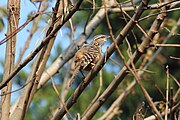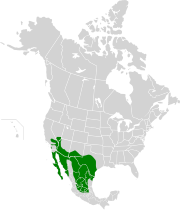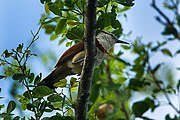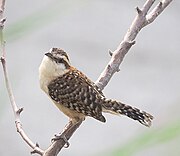Superregnum: Eukaryota
Regnum: Animalia
Subregnum: Eumetazoa
Cladus: Bilateria
Cladus: Nephrozoa
Superphylum: Deuterostomia
Phylum: Chordata
Subphylum: Vertebrata
Infraphylum: Gnathostomata
Superclassis: Tetrapoda
Cladus: Reptiliomorpha
Cladus: Amniota
Classis: Reptilia
Cladus: Eureptilia
Cladus: Romeriida
Subclassis: Diapsida
Cladus: Sauria
Infraclassis: Archosauromorpha
Cladus: Crurotarsi
Divisio: Archosauria
Subsectio: Ornithodira
Subtaxon: Dinosauromorpha
Cladus: Dinosauria
Ordo: Saurischia
Cladus: Eusaurischia
Cladus: Theropoda
Cladus: Neotheropoda
Cladus: Averostra
Cladus: Tetanurae
Cladus: Avetheropoda
Cladus: Coelurosauria
Cladus: Maniraptoromorpha
Cladus: Maniraptoriformes
Cladus: Maniraptora
Cladus: Pennaraptora
Cladus: Eumaniraptora
Cladus: Avialae
Infraclassis: Aves
Ordo: Passeriformes
Subordo: Passeri
Infraordo: Passerida
Superfamilia: Certhioidea
Familia: Troglodytidae
Genus: Campylorhynchus
Species: C. albobrunneus – C. brunneicapillus – C. capistratus – C. chiapensis – C. fasciatus – C. griseus – C. gularis – C. humilis – C. jocosus – C. megalopterus – C. nuchalis – C. rufinucha – C. turdinus – C. yucatanicus – C. zonatus
Name
Campylorhynchus Spix, 1824
Typus
Opetiorhynchus turdinus Wied-Neuwied, 1821 = Campylorhynchus turdinus
References
Spix, J.B. von 1824. Avium species novae, quas in itinere per Brasiliam annis MDCCCXVII-MDCCCXX jussu et auspiciis Maximiliani Josephi I. Bavariae regis augustissimi. Suscepto. Collegit et descripsit Dr. Joannes Bapt. de Spix. Curavit Martius, C.F.P. von. 1: 90 pp. + 104 tt. Illustrations: Matthias Schmidt. Ed. Monachii, Impensis Editoris, 1838. DOI: 10.5962/bhl.title.63181 Original description p.77 BHL Reference page.
Vázquez-Miranda, H., Navarro-Sigüenza, A.G. & Omland, K.E. 2009. Phylogeography of the Rufous-Naped Wren (Campylorhynchus rufinucha): Speciation and Hybridization in Mesoamerica. The Auk 126(4):765-778. DOI: 10.1525/auk.2009.07048 Full article view Reference page.
Vernacular names
suomi: Helmipeukaloiset
Campylorhynchus is a genus of wrens, which has at least 15 described species. At 17–22 cm (6.8-8.7 in) long, these are the largest-bodied of wrens, including the largest species, the giant wren. Member species are found in South and Central America and in some cases, as far north as the southwestern United States.
Taxonomy
A 2007 genetic study established the following relationships between species, including some selected subspecies:[1]
| Campylorhynchus |
|
||||||||||||||||||||||||||||||||||||||||||||||||||||||||||||||||||||||||||||||||||||||||||||||||||||||
Species
| Common name | Scientific name [a] | IUCN Red List Status | Distribution | Picture |
|---|---|---|---|---|
| Band-backed wren | Campylorhynchus zonatus (Lesson, 1832) |
LC IUCN[2] |  |
|
| Bicolored wren | Campylorhynchus griseus (Swainson, 1837) |
LC IUCN[3] |  |
|
| Boucard's wren | Campylorhynchus jocosus PL Sclater, 1859 |
LC IUCN[4] |  |
|
| Cactus wren | Campylorhynchus brunneicapillus Lafresnaye, 1835[5] |
LC IUCN[6] |  |
 |
| Fasciated wren | Campylorhynchus fasciatus (Swainson, 1837) |
LC IUCN[7] |  Ecuador S4E1692 (17142371156).jpg" decoding="async" srcset="//upload.wikimedia.org/wikipedia/commons/thumb/3/3f/Fasciated_Wren_-_South_Ecuador_S4E1692_%2817142371156%29.jpg/270px-Fasciated_Wren_-_South_Ecuador_S4E1692_%2817142371156%29.jpg 1.5x, //upload.wikimedia.org/wikipedia/commons/thumb/3/3f/Fasciated_Wren_-_South_Ecuador_S4E1692_%2817142371156%29.jpg/360px-Fasciated_Wren_-_South_Ecuador_S4E1692_%2817142371156%29.jpg 2x" data-file-width="1140" data-file-height="760" height="120" width="180" /> Ecuador S4E1692 (17142371156).jpg" decoding="async" srcset="//upload.wikimedia.org/wikipedia/commons/thumb/3/3f/Fasciated_Wren_-_South_Ecuador_S4E1692_%2817142371156%29.jpg/270px-Fasciated_Wren_-_South_Ecuador_S4E1692_%2817142371156%29.jpg 1.5x, //upload.wikimedia.org/wikipedia/commons/thumb/3/3f/Fasciated_Wren_-_South_Ecuador_S4E1692_%2817142371156%29.jpg/360px-Fasciated_Wren_-_South_Ecuador_S4E1692_%2817142371156%29.jpg 2x" data-file-width="1140" data-file-height="760" height="120" width="180" /> |
|
| Giant wren | Campylorhynchus chiapensis Salvin & Godman, 1891 |
LC IUCN[8] |  |
|
| Grey-barred wren | Campylorhynchus megalopterus Lafresnaye, 1845 |
LC IUCN [9] |  |
|
| Veracruz wren | Campylorhynchus rufinucha (Lesson, 1838) |
LC IUCN[10] |  |
|
| Sclater's wren | Campylorhynchus humilis PL Sclater, 1857 |
LC IUCN[11] |  |
|
| Rufous-backed wren | Campylorhynchus capistratus (Lesson, 1842) |
LC IUCN[12] |  |
|
| Spotted wren | Campylorhynchus gularis Sclater, 1861 |
LC IUCN[13] |  |
|
| Stripe-backed wren | Campylorhynchus nuchalis Cabanis, 1847 |
LC IUCN[14] |  |
|
| Thrush-like wren | Campylorhynchus turdinus (Wied, 1821) |
LC IUCN[15] |  |
|
| White-headed wren | Campylorhynchus albobrunneus (Lawrence, 1862) |
LC IUCN[16] |  |
|
| Yucatan wren | Campylorhynchus yucatanicus (Hellmayr, 1934) |
NT IUCN[17] |  |
Notes
A binomial authority in parentheses indicates that the species was originally described in a genus other than Aviceda .
References
Barker, F. Keith (2007-04-01). "Avifaunal interchange across the Panamanian isthmus: insights from Campylorhynchus wrens". Biological Journal of the Linnean Society. 90 (4): 687–702. doi:10.1111/j.1095-8312.2007.00758.x. ISSN 0024-4066.
BirdLife International (2012). "Campylorhynchus zonatus". IUCN Red List of Threatened Species. 2012. Retrieved 26 November 2013.
BirdLife International (2012). "Campylorhynchus griseus". IUCN Red List of Threatened Species. 2012. Retrieved 26 November 2013.
BirdLife International (2012). "Campylorhynchus jocosus". IUCN Red List of Threatened Species. 2012. Retrieved 26 November 2013.
"Campylorhynchus brunneicapillus". Integrated Taxonomic Information System. Retrieved 9 February 2006.
BirdLife International (2012). "Campylorhynchus brunneicapillus". IUCN Red List of Threatened Species. 2012. Retrieved 26 November 2013.
BirdLife International (2012). "Campylorhynchus fasciatus". IUCN Red List of Threatened Species. 2012. Retrieved 26 November 2013.
BirdLife International (2012). "Campylorhynchus chiapensis". IUCN Red List of Threatened Species. 2012. Retrieved 26 November 2013.
BirdLife International (2012). "Campylorhynchus megalopterus". IUCN Red List of Threatened Species. 2012. Retrieved 26 November 2013.
BirdLife International 2016. Campylorhynchus rufinucha. The IUCN Red List of Threatened Species 2016: e.T103887340A94287792. https://doi.org/10.2305/IUCN.UK.2016-3.RLTS.T103887340A94287792.en. Downloaded on 29 June 2019.
BirdLife International 2016. Campylorhynchus humilis. The IUCN Red List of Threatened Species 2016: e.T103887386A104216660. https://doi.org/10.2305/IUCN.UK.2016-3.RLTS.T103887386A104216660.en. Downloaded on 29 June 2019..
BirdLife International 2016. Campylorhynchus capistratus. The IUCN Red List of Threatened Species 2016: e.T103887650A104216920. https://doi.org/10.2305/IUCN.UK.2016-3.RLTS.T103887650A104216920.en. Downloaded on 29 June 2019.
BirdLife International (2012). "Campylorhynchus gularis". IUCN Red List of Threatened Species. 2012. Retrieved 26 November 2013.
BirdLife International (2012). "Campylorhynchus nuchalis". IUCN Red List of Threatened Species. 2012. Retrieved 26 November 2013.
BirdLife International (2012). "Campylorhynchus turdinus". IUCN Red List of Threatened Species. 2012. Retrieved 26 November 2013.
BirdLife International (2012). "Campylorhynchus albobrunneus". IUCN Red List of Threatened Species. 2012. Retrieved 26 November 2013.
BirdLife International (2012). "Campylorhynchus yucatanicus". IUCN Red List of Threatened Species. 2012. Retrieved 26 November 2013.
Retrieved from "http://en.wikipedia.org/"
All text is available under the terms of the GNU Free Documentation License

